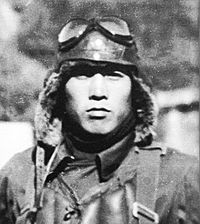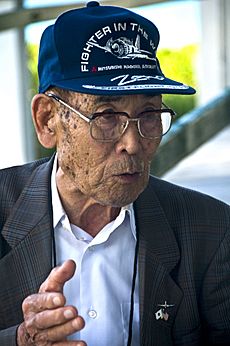Kaname Harada facts for kids
Quick facts for kids
Kaname Harada
|
|
|---|---|

Harada in 1943
|
|
| Born | 11 August 1916 Nagano Prefecture, Japan |
| Died | 3 May 2016 (aged 99) Nagano, Nagano Prefecture, Japan |
| Service/ |
Imperial Japanese Navy Air Service |
| Rank | Lieutenant (junior grade) |
| Battles/wars | Second Sino-Japanese War Pacific War |
| Other work | Dairy farmer, kindergarten principal, anti-war activist |
Kaname Harada (原田要, 11 August 1916 – 3 May 2016) was a famous Japanese pilot during World War II. He was known as a "flying ace" because he shot down many enemy planes. Some reports say he shot down as many as 19 Allied aircraft. This happened between late 1941 and October 1942, when his own plane was shot down.
After he recovered from his injuries, Harada became a flying instructor. He taught other pilots for the rest of the war. After the war ended in 1945, Harada worked as a farmer. Later, in 1965, he started a nursery for children. He then opened a kindergarten. From 1991, he became an activist who spoke out against war. He continued to share his message until he was very old.
Contents
Harada's Early Life and Military Service
Kaname Harada was born in a village called Asajawa in Nagano Prefecture, Japan. This was on August 11, 1916. When he was 17, in 1933, he joined the Imperial Japanese Navy. He first served in the naval infantry force. Later, he moved to the Navy's aviation branch, which means he became a pilot. In February 1937, he finished his pilot training. He was the top student in his class.
Service in China
In October 1937, Harada was sent to China. This was during the Second Sino-Japanese War. He did not fight in any air battles there. While in China, he saw Japanese soldiers harming Chinese civilians. He later said this was because the soldiers thought the civilians were disguised enemy fighters. In December, he was part of an attack on an American ship, the USS Panay. This event caused more tension between Japan and the United States. Harada returned to Japan in January 1938. After that, he worked in several training jobs.
World War II Battles
When the Pacific War started, Harada was a pilot flying a Mitsubishi A6M Zero plane. He was assigned to the aircraft carrier Sōryū. This ship was part of the 1st Air Fleet. He took part in many operations during the first months of the war.
On December 7, 1941, he flew patrols over the fleet during the attack on Pearl Harbor. He did not see any combat that day. Harada also flew with planes that attacked the Australian port of Darwin on February 19, 1942.
During the Indian Ocean raid, he shot down three British fighter planes over Colombo on April 5. He also claimed two more planes as "probables," meaning he likely shot them down. Four days later, he shot down two British Bristol Blenheim bombers. These bombers were trying to attack the Japanese fleet.
Battle of Midway and Injuries
During the Battle of Midway, Harada shot down several American planes. Sources say he shot down either three or five. His ship, the Sōryū, was sunk by American aircraft. Harada landed on the last Japanese aircraft carrier that was still afloat, the Hiryū. When the Hiryū was also sunk later in the battle, Harada was in the air. He had to ditch his plane into the sea and was rescued by a warship.
In July 1942, Harada was moved to another aircraft carrier, the Hiyō. In early October, this carrier left Japan to join the Guadalcanal Campaign. On October 17, Harada was part of a group of planes escorting torpedo bombers. These bombers were trying to attack targets on Guadalcanal. American Grumman F4F Wildcat planes attacked Harada's group. Harada likely shot down a Wildcat, but his own plane was badly damaged. His plane crash-landed near a Japanese base on Santa Isabel Island. Harada had to dig himself out from under the plane's wreckage with his bare hands. He was later sent back to Japan on a hospital ship.
His arm was badly injured in the crash. This injury ended his career as a combat pilot. After that, he became a flying instructor. Late in the war, he trained kamikaze pilots. These pilots would fly their planes into enemy ships. He also said he helped train pilots for the Mitsubishi J8M rocket plane. This was a new type of plane Japan was developing. By the end of the war, he was a lieutenant (junior grade). He had flown for 8,000 hours. The exact number of planes Harada shot down is debated. Some sources say nine, while Harada himself said 19.
Life After the War
New Beginnings
After World War II, Kaname Harada first worked as a dairy farmer. He had nightmares where he saw the faces of the American airmen he had shot down. In 1965, his wife asked him, "If you want to make up for the lives you have taken, what better way is there than to nurture new lives?" Because of this, he started a nursery for children with his wife. In 1969, they opened a kindergarten. He worked as the principal of the kindergarten until he retired.
Harada also traveled to the United Kingdom and the United States. He met some of the American and British airmen he had fought against. One of them was the American ace Joe Foss, who may have been the pilot who shot down Harada's plane. During his travels, Harada visited Santa Isabel Island. He found the wreckage of his fighter plane there and brought a piece of it back to Japan.
Speaking Out for Peace
From 1991, Harada became an activist against war. He started giving public talks about his experiences in combat. He spoke about the importance of avoiding wars. He began doing this after he heard young Japanese people talking about the bombing during the Gulf War. They spoke as if it were just a video game.
In 2015, The New York Times newspaper reported that Harada was 98 years old. He was a very popular public speaker. He wanted to share his experiences as a warning to younger generations in Japan. He believed they did not understand what war was truly like. He was against efforts by some Japanese politicians to change the country's peaceful constitution. He said, "these politicians were born after the war, and so they don’t understand it must be avoided at all costs. In this respect, they are like our prewar leaders." A documentary about Harada's life, called Each and Every Battlefield, was released in Japan in March 2015.
Kaname Harada passed away in Nagano on May 3, 2016. He was believed to be the last surviving Japanese combat pilot who had taken part in both the attack on the USS Panay and the attack on Pearl Harbor.
See also
 In Spanish: Kaname Harada para niños
In Spanish: Kaname Harada para niños


